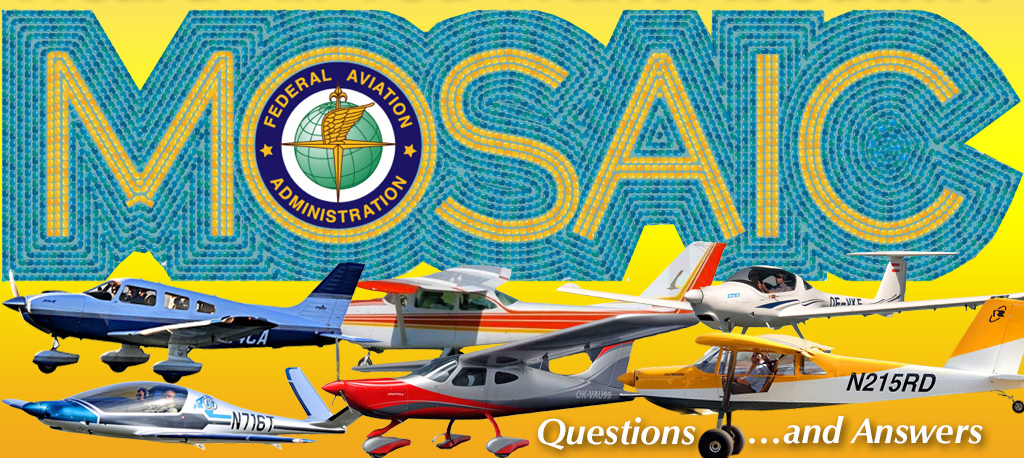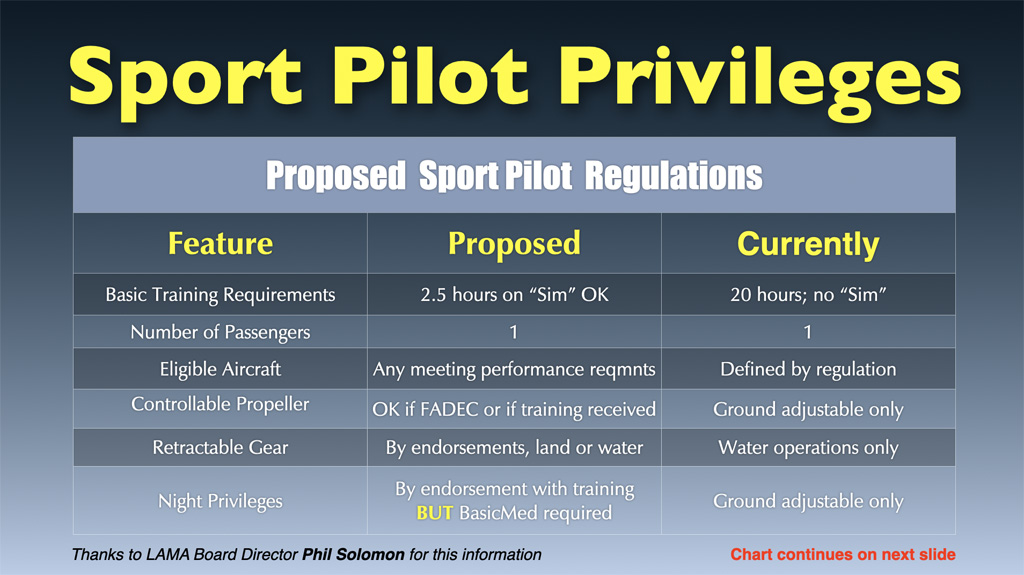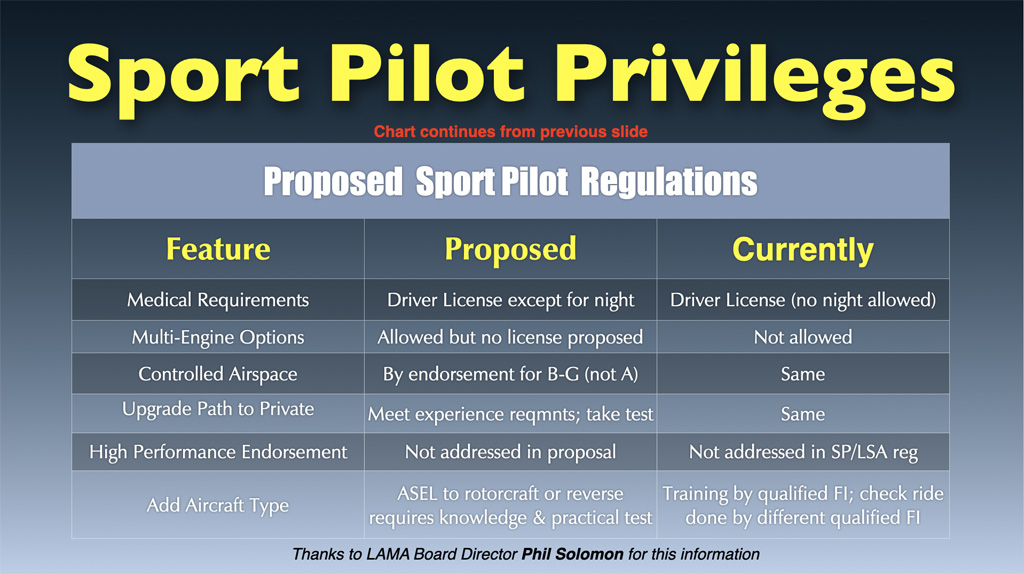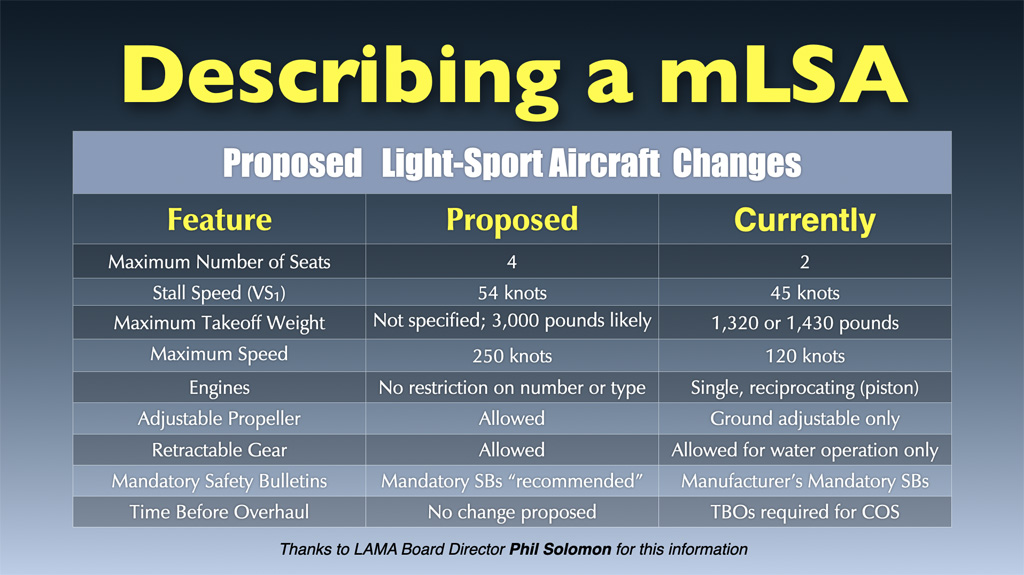 There’s little question we’ve covered MOSAIC extensively here on ByDanJohnson.com and have been looking ahead to a day when the proposal is a rule, sport pilots gain access to a whole raft of new aircraft, legacy LSAs have a chance to expand their operating envelopes and many of the companies planning to make new models that fit into the MOSAIC template actually come to market. Yeah, that’s a lot. And, yes, we’re all a little impatient for the FAA to make MOSAIC real.
There’s little question we’ve covered MOSAIC extensively here on ByDanJohnson.com and have been looking ahead to a day when the proposal is a rule, sport pilots gain access to a whole raft of new aircraft, legacy LSAs have a chance to expand their operating envelopes and many of the companies planning to make new models that fit into the MOSAIC template actually come to market. Yeah, that’s a lot. And, yes, we’re all a little impatient for the FAA to make MOSAIC real.
Since the comment period closed in January, there’s been plenty of industry talk and one major airshow where MOSAIC was definitely a topic of conversation. With that in mind, Dan Johnson, Scott Severen (LAMA’s president) and I are meeting next week (virtually) to catch each other up on the program—video of this meeting will post here next week.
As we prepare for it, I’d like to invite you to submit questions you have and we’ll take them up during our chat. Pop ‘em into the comments section below and we’ll include them in our discussion.
Back to Timelines
Recent reporting (for example, on AVweb) helps clarify a few things. First of all, the timeline. It was understood early on that the FAA was planning on taking 16 months to review public and industry comments, starting from the close of comments. As you probably remember, that was extended from October 2023 to January of this year. Then there was another shorter extension to fix a few “technical” issues with the original proposal, mainly relating to rules around noise and noise testing. My sources say that the FAA is unlikely to add that additional delay to the overall timeline.
There was chatter early on that the FAA might have some kind of announcement at AirVenture this year, but anything beyond “yes, we’re still working on it” seems unlikely. The FAA tends not to do rulemaking in public (after the comment period, anyway), so it’s likely that we won’t hear much until we get the final rule.
But that’s not the end of it. Once the FAA has published its final rule on MOSAIC, the ASTM committees may have to refine their standards based on the final rule and the FAA will need to approve it. Of course, this back-and-forth is already going on, so it’s not like the ASTM committees are working in a vacuum and no one I’ve talked to is predicting massive rewrites. But, according to sources, the approval process on the airframe side could take from 2 to 6 months after the rulemaking is made final. So even if the FAA and the ASTM committees are in close agreement, it still won’t be an instant-on situation.
Where does that get us? According to EAA’s Dick Knapinski, “It is correct that early to mid-2025 is expected to be the announcement of the final rule. We’ve been telling those who ask that, based on our conversations with the FAA, most recently at our annual winter summit in Oshkosh in early March.” But if the approval process stretches out, it could be December of 2025 before the new rules are widely in effect.
Which means the biggest challenge we face with MOSAIC is mustering patience.
In case you missed the broad strokes:





Mr. Johnson,
I was medically denied in 2018, I was then and still now under a Doctors care for restless leg syndrome. The medication I am prescribed is Pramipexole (Mirapex) this drug is indicated for Parkinson’s disease. Thankfully, I do not have Parkinson’s. Due to my 2018 flight surgeon physical denial, will this continue to impede me from becoming a sport pilot or under the new mosaic ruling, do I still have a chance?
Mosaic will not likely help as we expect nothing better than the “drivers-license medical” for LSA. I am not an expert; others may offer better advice. However, I would go back to the same flight surgeon after either dropping that prescription or getting clarification that it is not for Parkinson’s in your case.
Great update, thank you.
Do you think the possibility will exist that you can go up to Basic Med as opposed to having a Medical after 2006 and coming down?
I’m not sure precisely what you’re asking but if you mean going “up” from a drivers license in lieu of a medical, only your doctor may know if you can successfully achieve BasicMed. However, such an inquiry should not present the chance of an official denial should you fail to pass a conventional aviation medical. Once you start the latter, you cannot stop and your AME is required to report any medical negatives. Be careful!
Right. I was trying not to be too wordy, but think I watered down my question. In reference to the night VFR mentioned in the chart in the article, it says the proposal would require BasicMed. My question is do you think a path would be available at some point where you would not have had to previously had a Class III Medical, and instead be able to do a more thorough physical with your Doctor than a drivers license, but of course less than an AME. It seems like MOSAIC would knock out most of what the Recreational Pilot class benefit is.
To be honest, I disagree with most people that believe they should throw a bunch of additional rights to the Sport class, I think the new proposal is just about right, and am grateful for the opportunity to fly. My reason for not being able to get a PPL is a bit silly (and no one in prison is guilty of course), but a line has to be drawn somewhere for safety.
This was the subject of much debate when I gave a talk at the Midwest LSA expo. A video is available if you wanna plow through at all.
I’d bet FAA received many comments about the night VFR as many pilots see value in arriving an hour after dark without having to overnight remotely somewhere. The same with IFR; they just want to get through a thin layer of clouds. Yet would every pilot be careful with the privilege?
Somewhere in FAA, perhaps the legal department some speculate, a great value is placed in aviation medicals. Many believe this faith is unwarranted and cannot be defended with statistics. As with SP/LSA (which took much longer due to the drivers license medical privilege), it may take someone at the top to push certain things through. This may be one of them.
I realize that did not directly answer your question but it’s what we know what this point. I think the best hope remains for Mosaic airplanes that can be flown by someone with a Sport Pilot certificate and only a drivers license as evidence of their medical fitness. Only time will tell.
What is “COS” as mentioned in the last line of the last chart?
It’s easy to overdo abbreviations but they are efficient. COS is Continued Operational Safety, an inspection and maintenance requirement of FAA that ASTM committee members address in various standards they create. —DJ
Sport pilots really need a pathway to IFR.
We hope that is coming with Mosaic; it’s been on the list for some time. However, creating an industry standard defining “IMC-lite” turned out to be difficult. No one wants to encourage flight into known icing, for example. Getting through a cloud deck is what most Sport Pilots I’ve surveyed have said they hope to do with IFR ops in their LSA.
I’m a little confused about IFR and night flying under MOSAIC. Will it be possible and what steps are required? Will those who have had Class I, II or III medical and/or BasicMed be able to fly IFR or night VFR when flying under MOSAIC with a drivers license?
While we do believe these privileges are coming, Ed, and while we know a great deal about how Mosaic aircraft may appear — what we don’t know is enough information about pilot licensure or certification and operating limitations. We’ll have to wait until the final version of the regulation is issued to convincingly answer your questions.
This is the way it seems to me. We are like the Wright Brothers here in America with this sport plane thing and the rest of the world is producing Jet travel while we slug along with single engine snails.
The price of aircraft is going up so fast by the time the regulations are adopted no one will be able to afford even the older aircraft. Why don’t they just eliminate the medical for all SEL, Piston, VFR aircraft under a certain weigh?
Let’s hope the industry doesn’t influence the FAA to limit the rule an exclude manufactured aircraft like they did originally. I would encourage everyone to voice opinions an help hold the line.
What will be the requirements to become an LSA CFI – i.e. any different than a current CFI?
What will the IFR requirements be – both for the aircraft type and the pilot?
These are good questions we cannot answer until FAA’s final document comes out. We were able to learn a lot about how the airplanes might look, but heard very little about pilot licensing and operating limitations.
There is no “LSA CFI”. Any CFI can instruct for sport pilot. CFI types are based on rating.
For instrument you’d use a CFI-I.
For multi engine you’d use a MEI.
There is a CFIS rating (61.419) that can be used to instruct Sport Pilot only. It has similar requirements to a CFI, however does not require a medical. There aren’t many CFIS as last I checked instruction from CFIS is not counted toward Private instuctor time.This means if you get a Sport License from a CFIS and want to get a Private, that insturction does not count toward the Private rating. That may have changed. Since CFIS intruction didn’t initially count toward Private and above, if you ever wanted to get a higher rating, it made sense to just use a regular CFI.
I am buying an LSA and want to know if LSR-M is going away. I want o be able to maintain my aircraft myself by taking the LSR-M class to do that. Reading Mosaic as it stands would indicate to work on LSA you now have to have the near equivalent training of A&P as LSR-M will disappear.
I would refer you to Rainbow Aviation about whom I have written several times. They are on top of this matter more than anyone I know.
Yes, there is some jeopardy as we saw in the proposal. My hope is that good pilot responses may correct this as FAA finalizes their plan.
HI, what happens to the L S A repairmen
Certificate?
Will all the new aircraft that will now be allowed under the new rules, to be serviced with those people that hold this
Certificate?
I’d be interested in hearing about the maintenance allowed with MOSAIC. What happens to the LS Repairman Certificate? Will there be a new offering?
My friend and I are both private pilots, both in our 60s and both are way out of currency, but we want to get active again. We’d prefer to get checked out in typical certified rented airplanes without getting medicals, therefore as sports pilots. Do you think the mosaic will make this possible?
I disagree with a BasicMed requirement for night flying, particularly for previously authorized pilots.
I agree, it’s a bizarre requirement that feels like it’s there just to remind us that we’re “inferior”.
It also boggles the mind to allow 4-place airplanes but keep the 1-passenger restriction.
I think the main reasons 4 place planes will be allowed is to increase the number of planes available for a sport pilot. Keeping the single passenger limitation makes sense as it is less of a distraction to have one person next to you, as opposed to three people, two in the back. Plus, those additional folks are chatting away and that has to be managed.
I mean if we really fly with two or three passengers regularly, we can always upgrade to PPL.
I would think that the 1 passenger restriction will prevent sport pilots from overloading an aircraft. It’s hard to get a plane to exceed max weight with 2 people but we know you can usually only carry 3 people in a 4 place plane because we weight a lot more than our ancestors. It’s more about eliminating the issue of a miscalculation from a less experienced pilot doing the calculations wrong or not at all.
Yes, that’s another good reason. Good point.
Sport pilots and private pilots do pretty much all the same w&b calcs during training. It’s simply a different POH
I’m not familiar with this requirement for night flying under BasicMed. Can you expand or give a reference to it. Also, is there something similar for IFR under BasicMed.
As Mosaic will allow for greater useful payload (such as total crew weight of 600 lbs), will aircraft design incorporate greater cabin height, width, and length for taller, heavier, and “wider” pilots and passengers?
Will Self Launch Gliders allow in flight adjustable prop? Will there be any change to VNE for Self Launch Gliders – currently limited to 120 knots TAS.
That’s a very good question I didn’t even think about mororgliders even though I’ve owned one. Curious if the answer or if they will just register them as fixed wing aircraft.
Thank you Dan for keeping us informed. You do a good job.
I would assume that once the rule is enacted, the Sport Pilot portions of it will be effective immediately even if some of the airframe/manufacturer items will require work on the part of ASTM to revise their standards to match.
That’s the expectation, yes.
I saw the ground adjustable only for night flight as well, surely that’s a typo.
Good catch! After the many times that chart has been shown, no one ever noted that, I suspect because the presentations were so full of detail this one simply was overlooked. Of course, you are correct. That is an error. It should read that night flight is presently not permitted. —DJ
Night privilegies are currently ground adjustabl only. Certainly you don’t need to adjust to night flying if you are on the ground…